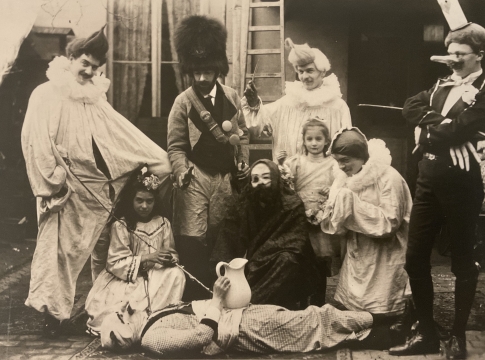The James Ensor Archives contains 140 metres of documents and other archival material relating to the work and period of James Ensor. The collection has been acquired by the Orcona Fund, managed by the King Baudouin Foundation, in 2024 and consolidates the archives assembled by the Mu.ZEE in Ostend. It provides a unique source of information for scientific research on Ensor.
A unique and diverse overview of James Ensor
This archival fund is the fruit of 40 years of research on James Ensor (1860-1949) and is exceptional for the exhaustiveness of its contents. Manuscripts, autographs, notebooks, speeches, drawings, engravings and photos, as well as posters, magazines, catalogues and works of artists in contact with Ensor, provide a unique and diverse overview of James Ensor, his entourage and his time. The value of these important archives lies in the fact that they provide diverse and comprehensive insights into James Ensor both as an artist and as a socially engaged citizen. The documents afford us a better understanding of Ensor’s environment, his network of friends (including Théo Hannon and the Rousseau family), his thoughts and his wide range of interests. Given the extent of the collection, the archives also contain a mine of information about other artists, printers and writers (mostly Belgian) of the period. Thanks to these archives and the wealth of their (unpublished) sources, which shed new light on the artist’s life, Ensor’s period can now be better understood.
Ensor, a multi-facetted artist
James Ensor was a painter, draftsman and engraver of unbounded imagination who is considered to be a leading figure and pioneer in the history of modern art. An excellent draughtsman, he also revealed himself to be a skilled engraver. Ensor was an inimitable creator who excelled in the art of derision. Whilst he exercised his art with great talent in the styles of Impressionism, Expressionism, Fauvism and Surrealism, Ensor also proved to be a pioneer for his time. At the age of 23, he sought to free himself from academicism and, together with some of his friends, founded the Group of XX, a circle of Belgian artists that included Théo van Rysselberghe, Fernand Khnopff, Anna Boch and Félicien Rops. At the annual art salons, Ensor also rubbed shoulders with famous artists such as Monet, Gauguin, Seurat, Whistler and Rodin. Ensor always had a deep affection for Ostend, the city of his birth, which provided him with inspiration for his work: the beach, carnival, music, local life and Chinoiseries. He played an active role in local social life and was committed to ecology (in advance of his time) and the preservation of Ostend’s unique heritage.
A centre of knowledge for research on Ensor
The Mu.ZEE of Ostend, which is a centre of knowledge about Belgian art from 1880 to the present time, possesses extensive archives relating to Ensor, as well as a huge collection of his work. Thanks to the acquisition of this exceptional collection by the Orcona Fund, the two archives are now kept in a single location. The Ensor Knowledge Centre has as its mission to re-group, structure and digitize the information on Ensor and to make this available to researchers and the general public. When the Museum reopens in 2028, Mu.Zee also wants to publish a collection catalogue.
The Orcona Fund
The Orcona Fund was founded in 2023 by an anonymous donor with a great passion for 19th-century art and the Impressionist and modern movements. With this Fund, he wants to support medium-sized Flemish museums specialising in his favourite art period. The Fund can support the acquisition of works, which are given on long-term loan to the museum, the restoration of important works or research within the collections.
